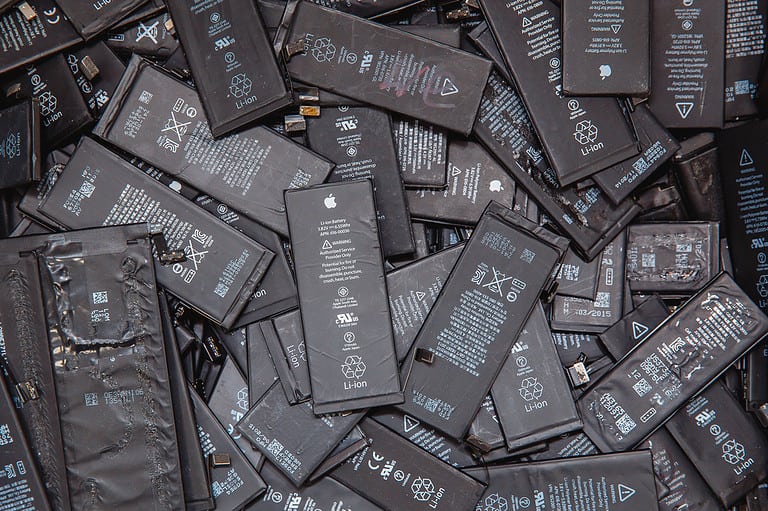The European Parliament has agreed to tighten sustainability rules for batteries. If the Commission also agrees with the plans to make batteries replaceable and more recyclable, many tech companies will face an uphill struggle. Still, this European vision may not be a resounding success overnight.
Brussels’ plans focus heavily on the future. The EU Battery Directive already stated that 70 percent of the weight of a lithium-ion battery should consist of recycled material. Now the EU has further outlined what requirements manufacturers must meet. Step by step, expectations for recycling percentages are going up. This includes the amount of recyclable materials as well as their use in new products.
These are clear targets based on existing trends. This is inextricably linked to European plans to ramp up its battery production, which is expected to supply 17 per cent of global demand by 2030. In competition with America, however, the bloc may need further investment to lure battery manufacturers to the continent. Yet the EU also demands more from others in laying out ambitious sustainability targets, possibly resulting in drastic design changes.
Easily replaceable
The significant advantage for the EU as a supranational body is that it can make guiding choices on behalf of consumers, forcing corporate behaviour to comply. Merely one example is the compulsory move to USB-C as the universal charging standard, even for the dawdling Apple, which remained wedded to its own Lighting cables until the bitter end. Now, the requirements for the tech industry include an accessible battery replacement. The EU will require batteries inside all portable devices to be “easily” replaceable.
That sounds simpler than it is. The thing is, phones from nearly two decades ago almost always had a simple mechanism to replace the battery. Since the advent of smartphones, that has become less and less common. Devices such as laptops and tablets sometimes tend to be difficult or impossible to tinker with, quickly turning them into e-waste.
Still, manufacturers will simply have to comply with EU rules. To be precise, it is not yet known what the fines are for violating this replacement requirement. However, with the hefty sums of money for GDPR violations, we see where the EU stands regarding consumer interests: those who don’t cooperate will pay the price. There’ll be no choice but to make battery accessibility achieve an acceptable level. What the EU will actually classify as acceptable remains to be seen. What if only a technician can practically replace a battery? Should AirPod cases and smartwatches also have the option to access their tiny components inside? It may be a requirement, but it remains to be seen how feasible the forced alteration of these products will be.
Recycling for big and small
The EU’s vision on batteries goes beyond just usability, however. The recycling targets are much more concrete and realistic than the aforementioned replaceability aim. For example, we know that lithium is difficult to recycle, resulting in only 6 per cent of this material having to be reused by 2030 compared to 16 per cent for cobalt.
Even heavier regulations apply to bigger batteries. These include the power units inside EVs, which are experiencing meteoric growth in Europe. They also contain alarmingly large amounts of lithium: often 8 kilograms per car. For these major components, there will be a “battery passport,” which will provide, on a digital basis, “detailed information on the material supply chain, the use of the battery and its health status.”
Opponents
In the discussion around replaceability and recyclability, the EU would undoubtedly like to see cooperation from manufacturers. The reality is that Europe’s interests are inherently different from those of suppliers. Increased recycling standards will reduce production in countries like South Korea, while the EU itself wants to drive battery production on its own continent.
In this regard, it has a tricky path to follow. On the one hand, it can set all sorts of requirements for products on the market. After all, nothing gets a “CE” label without approval, no matter where it has been made. It will get tough for the EU to expand its supply simply because it is not alone in developing subsidies to lure these manufacturers. The U.S. government can dish out up to $10 billion (€9.15 billion) per production plant thanks to the Inflation Reduction Act from late 2022. Now it is up to the EU to do something in return. The US has no equivalent to the EU’s battery sustainability law. Therefore, the result could easily be that while manufacturers adopt EU sustainability requirements, they may largely ignore the continent regarding workplaces and production capacities.
Miss the mark?
The EU’s vision on batteries is based on well-founded views with realistic targets to aim for. Battery replaceability is also an essential component of sustainability. The right-to-repair movement has been championing it for years. Where it gets trickier is how the EU can reconcile all this with the “strategic autonomy” it is increasingly clinging to. After all, it will have to provide loads of money in subsidies for battery manufacturers or risk losing them altogether.
In this, the issue has parallels with the EU approach when it comes to AI. The desire to regulate the technology also garnered an overwhelming majority. Still, one wonders whether this does not weaken the competitive position against less strict entities like the US. At least with battery legislation, brands simply can’t miss out on Europe’s common market as a major source of income. As a result, it could at least become a pivotal driver of sustainability within this sector.
